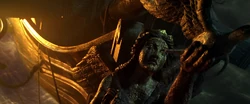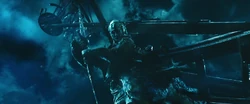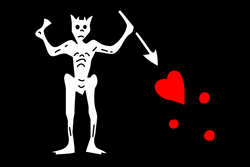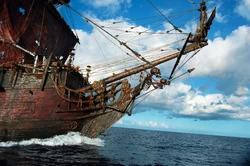
- "If the figurehead was on Opawiwato, Sterling had to find it; by what ever means necessary."
- ―Gunner
A figurehead was a carved wooden decoration found at the bow and prow of sailing ships, generally of a design related to the name or role of a ship. In the perilous life of an ocean-going ship, figureheads embodied the spirit of the vessel, offering the crew, sailors, officers and passengers protection from harsh seas and safeguarding their homeward journeys. As such, they were often lovingly cared for by the crew. The superstitions of seamen meant that the figurehead held great significance to those on board and they would go to great lengths to protect it.
Early ships often had some form of bow ornamentation, notably the Viking ships of circa A.D. 800–1100, with the menacing appearance of toothy and bug-eyed figureheads considered a form of apotropaic magic, serving the function of warding off evil spirits. A general practice of figureheads was introduced in Europe with the galleons of the sixteenth centuries. They were predominant during the Age of Piracy, used by the British Royal Navy, Spanish Navy, and pirate vessels. In the period from the seventeenth to the eighteenth centuries, the carved subjects of figureheads varied from representations of saints to patriotic emblems, such as the design with unicorns or lions popular on British ships.
History

- "Mates, I now libate—if there indeed be such a word, which I rather doubt—our lovely angel here. May she watch out for us, keep us safe, and guide us on our journeys!"
- ―Jack Sparrow to his crew
A general practice of figureheads at the bow of ships was introduced in Europe with the galleons of the sixteenth centuries, and was predominant during the Age of Piracy, used by the British Royal Navy, Spanish Royal Navy, and pirate vessels. Mariners believed the eyes of the figurehead would help their ship to find its way at sea. Like all mariners, pirates were a superstitious bunch, and they believed that women on board a ship would always bring bad luck. They made one exception: wooden women were allowed, but only if they were nailed to the bow as a figurehead.[1][2]
One of the earliest known figureheads was the Flying Dutchman, the cursed ghost ship of Davy Jones, where at the bows hung a skull or skeleton,[3] riding the bowsprit as if lashed there in punishment."[4] Another description was a carved statue of the legendary figure, the Grim Reaper, which cuts off lives as if cutting corn with his scythe. It was a fitting figurehead, for Jones no longer simply collected the souls of drowning sailors, but now he dragged them to their doom.[1][5]
By the adventures of young Jack Sparrow, Captain Edward Teague, the most wanted pirate of the Seven Seas as Keeper of the Pirate Code of the Brethren Court, had the Misty Lady, a rundown pirate ship with a figurehead of a woman with a tail for legs decorated its bow.[6]
Sparrow and Teague later encountered the Silent Mary, the Spanish Navy galleon of the ruthless pirate hunter Armando Salazar, had the figurehead of a woman holding a spear and a shield. During the massive sea battle against the Silent Mary, Sparrow defeated Salazar from aboard Captain Morgan's pirate ship Wicked Wench, which had the figurehead of a woman with a bird in her outstretched hands.[7]

When Jack Sparrow pursued a legitimate career as a merchant seaman for the East India Trading Company, he was made captain of the merchant ship called the Wicked Wench, which didn't have a figurehead, by the EITC official Cutler Beckett, who later set the Wench aflame and sunk. After his beloved ship was raised from the depths in a deal with Davy Jones, Jack sometimes wondered why Jones felt it necessary to supply the resurrected and transformed Wicked Wench with a beautiful figurehead that was completely new to the ship, which Jack then rechristened as the Black Pearl. The Black Pearl's ornately carved figurehead showed a woman with an outstretched left arm and a bird about to take flight from her hand,[1][2] also considered a graceful black angel, cupping her outstretched left hand to release a black dove into flight, as well as symbolized Captain Jack Sparrow's goal for freedom.[8] Years later, Elizabeth Swann saw the figurehead before climbing aboard the Black Pearl, under the command of the cursed Captain Hector Barbossa.[9][10][11][4]
Most pirates of the Caribbean sailed under the Jolly Roger, a black flag sporting a skull and crossbones, but Edward "Blackbeard" Teach's flag featured the skeleton of the devil sticking a spear into a blood red heart, an intimidating flag to go with his murderous reputation aboard the Queen Anne's Revenge.[12] At some point, Blackbeard had gained supernatural powers and began flying a pirate flag with a flaming skull,[13] while the Queen Anne's Revenge had a figurehead based on the ensign of Blackbeard's original flag, a great horned skeleton clutching a goblet of wine in one hand and holding a spear in the other, as if Blackbeard was toasting his plundering or his victims.[14][15]

The ships of the British Royal Navy carried the figureheads that proclaimed their allegiance to the British Empire, most notably the design with the lion standing for England and the unicorn for Scotland, holding together as the symbol of the royal coat of arms of Great Britain. Under the command of James Norrington, the figurehead of the HMS Dauntless showed a lion and a unicorn. One smaller ship, the brig HMS Interceptor, only had a lion for a figurehead.[11] The HMS Endeavour, the flagship of Lord Cutler Beckett of the East India Trading Company, had a figurehead similar to that of the Dauntless—two animals holding a red shield with three identical gold lions, the Royal Arms of England.[16] Many years later, the Monarch under Captain Toms had a crowned lion for a figurehead, while the Essex of Lieutenant John Scarfield had a king holding a sword.[7]

After decades of imprisonment in the Devil's Triangle, the cursed Spanish Navy ghost Capitán Salazar and the crew of the Silent Mary were free to take command of the sea, with the ship and the figurehead of a woman holding a spear and a shield becoming living tools of Salazar's revenge against the pirates in the Caribbean. During the battle between the Silent Mary and the Black Pearl, Salazar used his supernatural powers to bring his ship's figurehead to life, using the wooden beast to hunt Captain Jack Sparrow. The living figurehead was crushed when the starboard side of the Pearl collided with the port side of the Mary.[7]
Behind the scenes
- "The figurehead of the Queen Anne's Revenge was based on Blackbeard's real flag, which was a great horned skeleton holding a goblet of wine in one hand and spear in the other; as if he's toasting his victims."
- ―John Myhre
Figureheads first appear in the 2003 junior novelization for the film Pirates of the Caribbean: The Curse of the Black Pearl.[9][11]
In Ted Elliott and Terry Rossio's early screenplay draft of The Curse of the Black Pearl, the figurehead of the H.M.S. Dauntless was described as a massive ship with "the Winged Victory maidenhead looming." The Black Pearl was also described as having, at the bow, an ornately carved figurehead of a beautiful woman, arm held high, a small bird taking wing from her outstretched hand.[17] Although this description of the Black Pearl was adapted in the 2003 junior novelization,[9] 2006 junior novelization,[10] and The Art of Pirates of the Caribbean,[4] among other sources, the 2006 German novelization by Wolfgang and Rebecca Hohlbein describes the figurehead of the Black Pearl as a black mermaid.[18] In addition, "a graceful black angel, cupping her outstretched left hand to release a black dove into flight" was written in A. C. Crispin's novel The Price of Freedom.[8]

The figurehead of the Flying Dutchman varied across media, beginning with the 2006-2007 sequels Dead Man's Chest and At World's End. According to Ted Elliott and Terry Rossio's screenplay for Dead Man's Chest, Davy Jones' Flying Dutchman had the description "A SKULL rides the bowsprit as if lashed there in punishment,"[19] which was also featured in The Art of Pirates book.[4] According to the reference books Pirates of the Caribbean: The Visual Guide and The Complete Visual Guide, the figurehead of the cursed Flying Dutchman was detailed as, at the bows of the ghost-ship hung a carved statue of the Grim Reaper.[1][5] However, both the Dead Man's Chest and At World's End novelizations incorrectly describe a carved skeleton of a winged female was attached to her bow.[20][21]
Figureheads appear in video games, such as At World's End video game adaptation.[22] One of the quests in the online game Pirates of the Caribbean Online requires a player to recover the figurehead of the Black Harbinger.[23]
In the book Jack Sparrow: Sins of the Father, the figurehead of the Misty Lady, Captain Teague's rundown pirate ship, was described as "a woman with a tail for legs" and was pictured in one of the book's pages.[6] While unconfirmed, it appears to be similar to the figurehead of a mermaid seen in the opening scene of the 1989 film The Little Mermaid.[24]
The figurehead of the Queen Anne's Revenge, as depicted in On Stranger Tides and Pirates Online, was based on Blackbeard's historical pirate flag, which had a great horned skeleton holding a goblet of wine in one hand and a spear in the other.[15] Since production designer John Myhre had already appropriated the skeleton from Blackbeard's real, historically correct flag for the ship's figurehead, a new design featuring a skull with flames was created for the pirate's flag in the film.[14] The Queen Anne's Revenge's figurehead appears in the non-canon video game Sea of Thieves: A Pirate's Life under the names "Collector's Royal Revenge Figurehead" and "Royal Revenge Figurehead".[25]
Pirates of the Caribbean: Dead Men Tell No Tales contains a continuity error where the skeletal figurehead of the Flying Dutchman is still on the ship's prow,[7] despite falling apart during the final battle of At World's End.[16]
The Silent Mary's figurehead in Dead Men Tell No Tales was mistakenly called the "Silent Mary Masthead" in the instruction booklet for the Lego Silent Mary set. The masthead is the uppermost point of a mast.[citation needed]
Appearances
- Jack Sparrow: Sins of the Father
- The Price of Freedom
- Pirates of the Caribbean: Legends of the Brethren Court
- Pirates of the Caribbean: Armada of the Damned
- Pirates of the Caribbean: The Curse of the Black Pearl
- The Sails of Doom!
- The Black Heart of the Pearl
- The Eyes Have It!
- Pirates of the Caribbean: Dead Man's Chest
- Pirates of the Caribbean: At World's End
- Pirates of the Caribbean: Tides of War
- Pirates of the Caribbean: On Stranger Tides
- The Brightest Star in the North: The Adventures of Carina Smyth
- Pirates of the Caribbean: Dead Men Tell No Tales
- Pirates of the Caribbean: Dead Men Tell No Tales Novelization
- Pirates des Caraïbes : La Vengeance de Salazar
- Pirates of the Caribbean: Dead Men Tell No Tales: Movie Graphic Novel
Non-canon appearances
- The Legend of Captain Jack Sparrow
- Pirates of the Caribbean: Battle for the Sunken Treasure
- Fantasmic!
- LEGO Pirates of the Caribbean: The Video Game
- Sea of Thieves: A Pirate's Life
Sources
- Pirates of the Caribbean: The Visual Guide
- Pirates of the Caribbean: The Complete Visual Guide
- The Art of Pirates of the Caribbean
- The Art of Pirates of the Caribbean: On Stranger Tides
External links
Notes and references
- ↑ 1.0 1.1 1.2 1.3 Pirates of the Caribbean: The Visual Guide
- ↑ 2.0 2.1 Pirates of the Caribbean: The Complete Visual Guide, pp. 28-29 "Black Pearl"
- ↑ Pirates of the Caribbean: Dead Man's Chest
- ↑ 4.0 4.1 4.2 4.3 The Art of Pirates of the Caribbean
- ↑ 5.0 5.1 Pirates of the Caribbean: The Complete Visual Guide, pp. 64-65: "The Flying Dutchman"
- ↑ 6.0 6.1 Jack Sparrow: Sins of the Father
- ↑ 7.0 7.1 7.2 7.3 Pirates of the Caribbean: Dead Men Tell No Tales
- ↑ 8.0 8.1 The Price of Freedom, Epilogue: The Black Pearl
- ↑ 9.0 9.1 9.2 Pirates of the Caribbean: The Curse of the Black Pearl (2003 junior novelization)
- ↑ 10.0 10.1 Pirates of the Caribbean: The Curse of the Black Pearl (2006 junior novelization)
- ↑ 11.0 11.1 11.2 Pirates of the Caribbean: The Curse of the Black Pearl
- ↑ Pirates of the Caribbean: On Stranger Tides (junior novelization)
- ↑ Pirates of the Caribbean: On Stranger Tides
- ↑ 14.0 14.1 The Art of Pirates of the Caribbean: On Stranger Tides
- ↑ 15.0 15.1 Did You Know? ...On Stranger Tides edition: Grog Blog - Archived
- ↑ 16.0 16.1 Pirates of the Caribbean: At World's End
- ↑ Wordplayer.com: PIRATES OF THE CARIBBEAN: THE CURSE OF THE BLACK PEARL by Ted Elliott & Terry Rossio
- ↑ Fluch der Karibik - Der Roman zum ersten Kinofilm, p. 85
- ↑ Wordplayer.com: WORDPLAY/Archives/Screenplay - PIRATES OF THE CARIBBEAN: DEAD MAN'S CHEST by Ted Elliott & Terry Rossio
- ↑ Pirates of the Caribbean: Dead Man's Chest (junior novelization)
- ↑ Pirates of the Caribbean: At World's End (junior novelization), p. 2
- ↑ Pirates of the Caribbean: At World's End (video game)
- ↑ Pirates of the Caribbean Online
- ↑
The Little Mermaid on Wikipedia
- ↑ Sea of Thieves: A Pirate's Life

